Distant Shores III
The New Boat at Dusseldorf
25/01/18 08:51
UPDATE Dusseldorf Video
Boot Dusseldorf is the largest indoor boat show - plus this year it has Distant Shores III in the show!! So here's a quick tour around so you can see what she looks like…
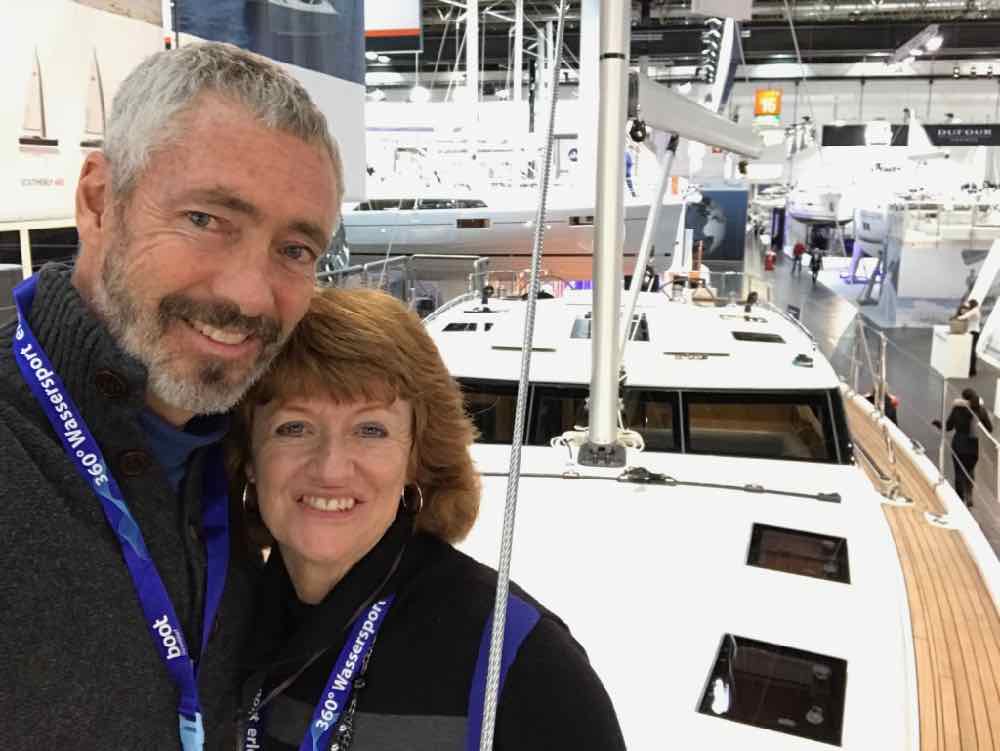
Here's the view as we walked in to see her finished for the first time!
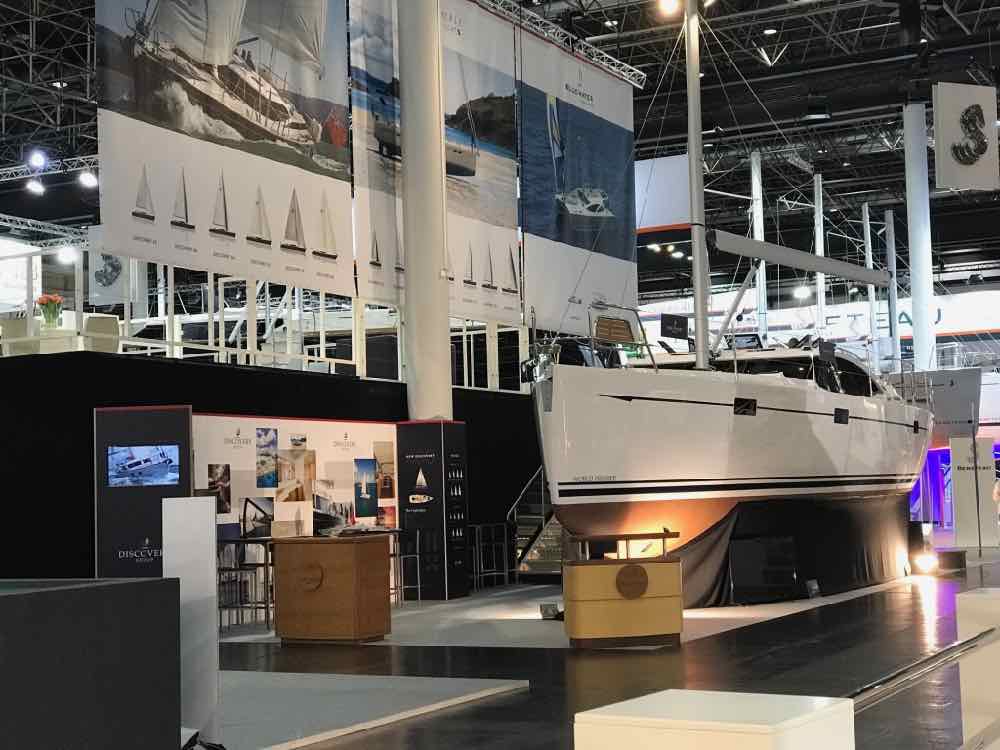
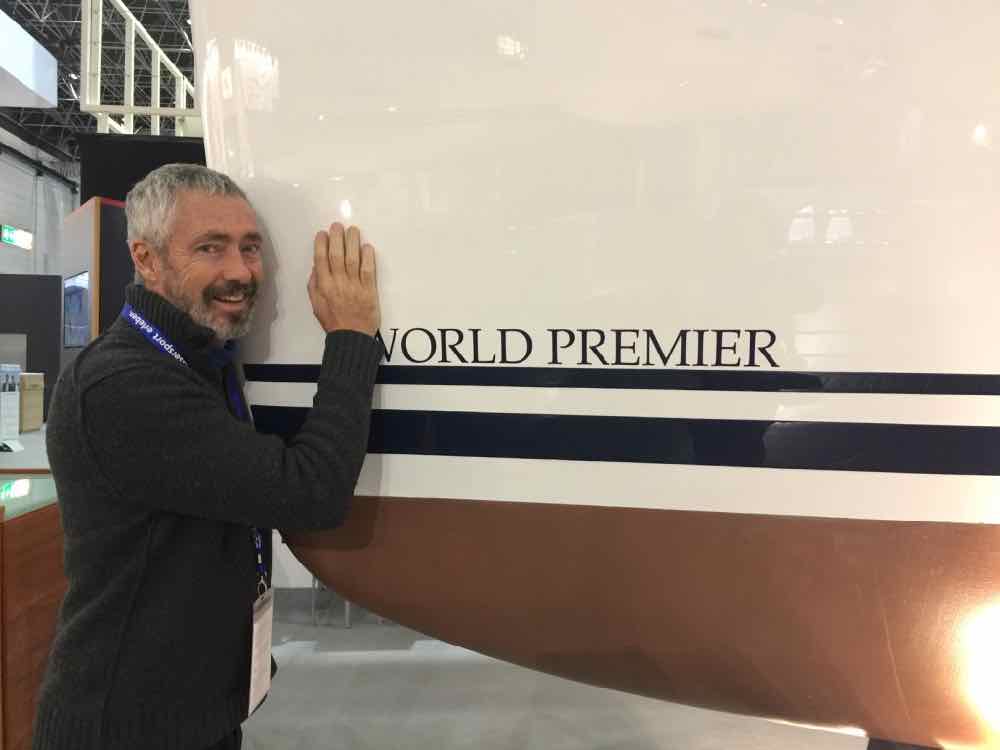
There is a spacious aft cockpit with centre table. The aft cabin is under the cockpit and the table acts as a skylight.
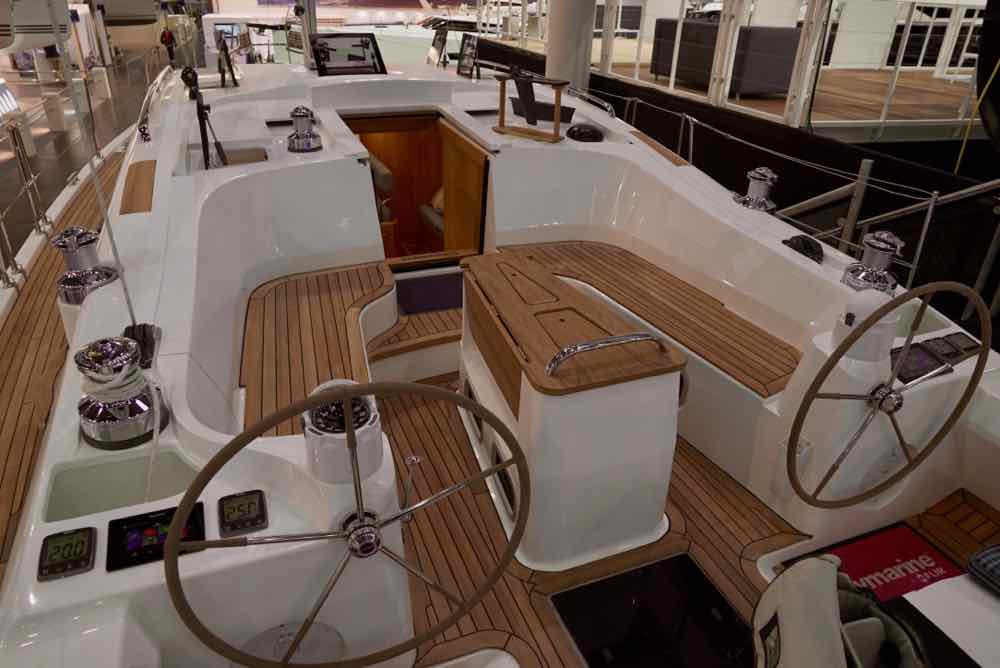
The galley is right at the bottom of the companionway for easy access. There is a fore-aft mounted fridge and a top loading freezer. The stove is a GN Espace model we've been excited to try out.

The saloon is raised for excellent views while seated.
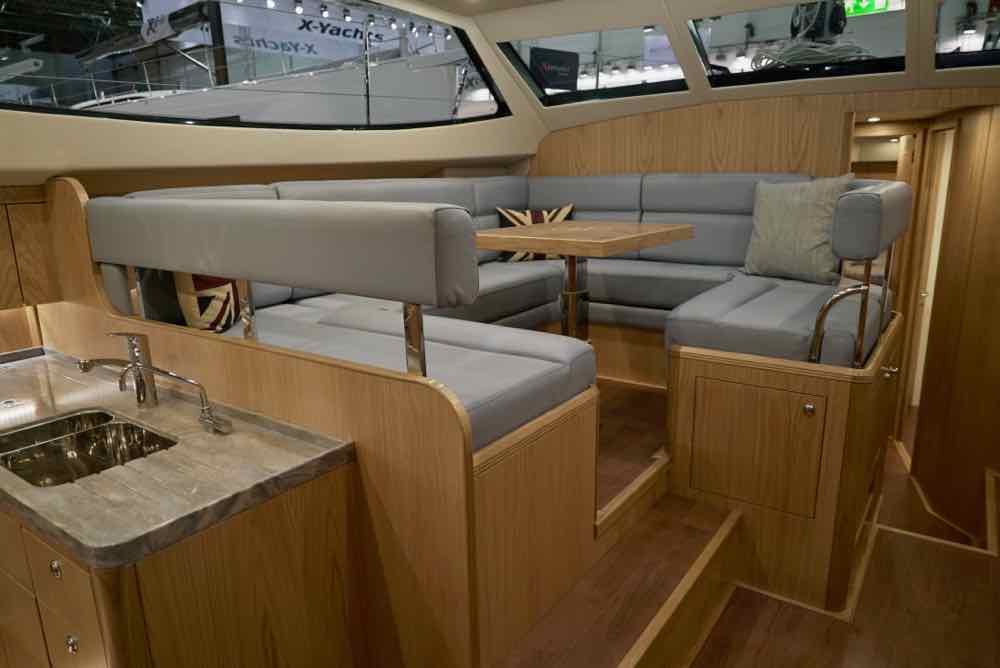
Forward are the bunk cabin and large double stateroom…

The bunk room has two good sea-berths and plenty of storage. It also has notices asking people not to sit or lie down on the bunks please - but they don't seem to work :-)
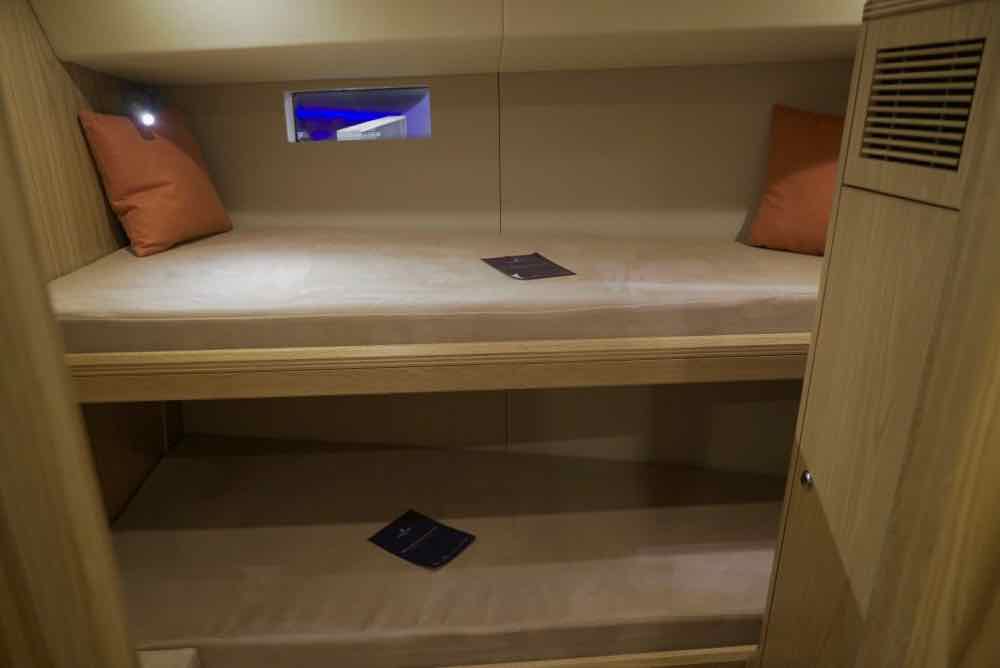
The forward cabin is large with lots of stowage…
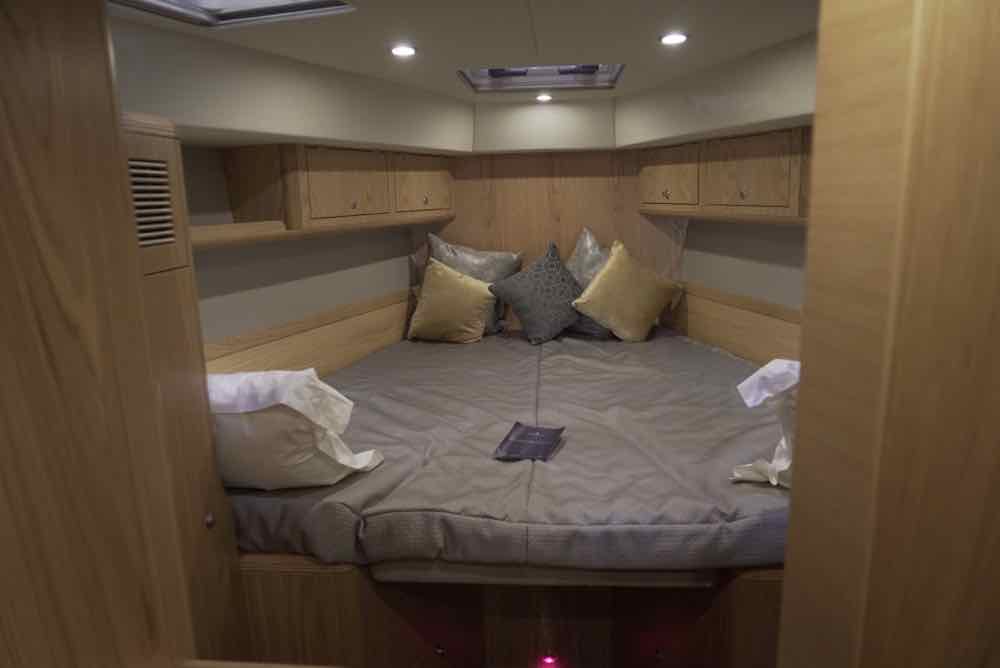
The forward heads has a separate shower.
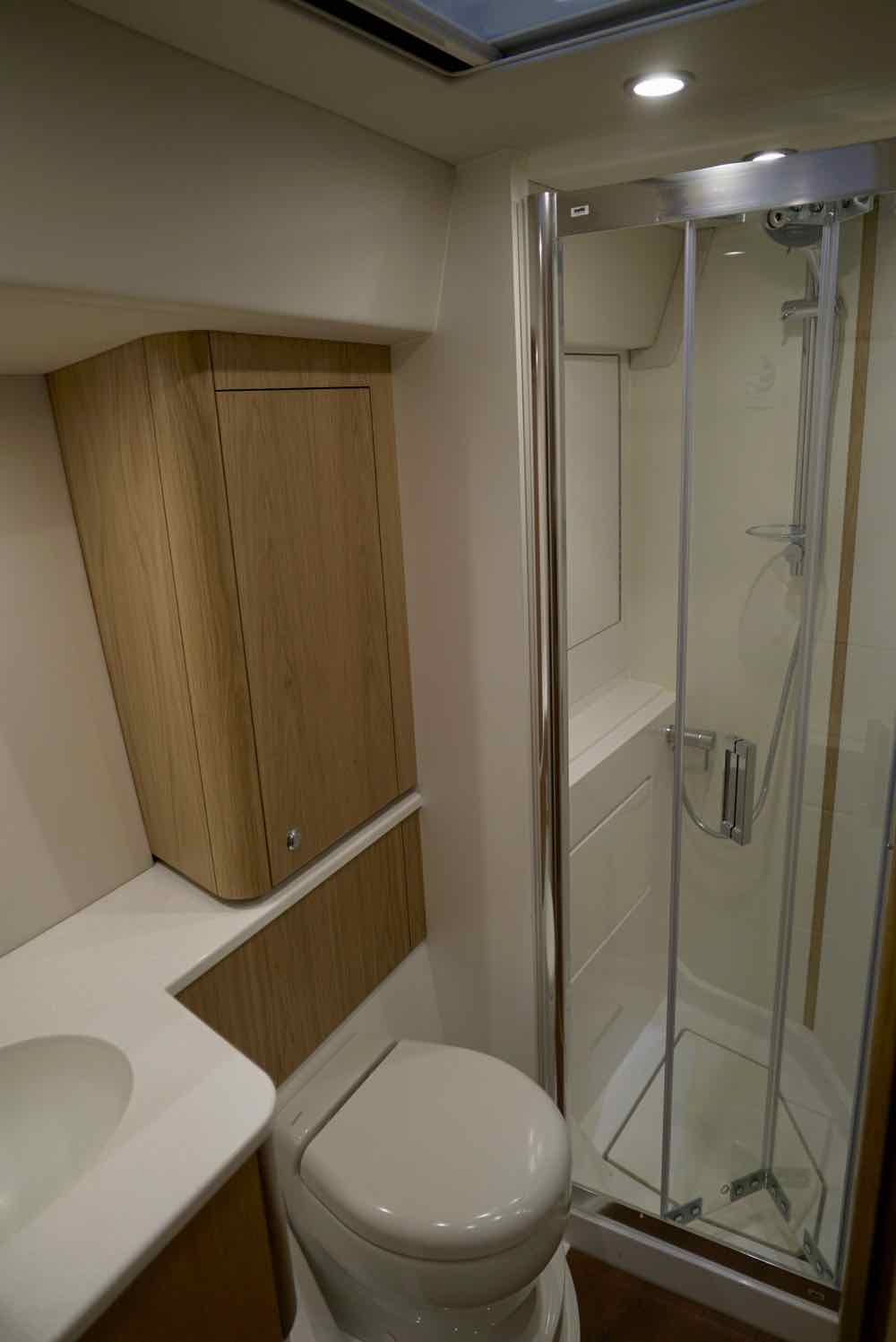
Back in the saloon the nav station has views forward so you can steer (using the missing Raymarine autopilot and plotter)

The aft cabin is palatial spanning the width of the stern under the cockpit. The cockpit table above provides 4 ventilation hatches. Side hull windows provide a good view.
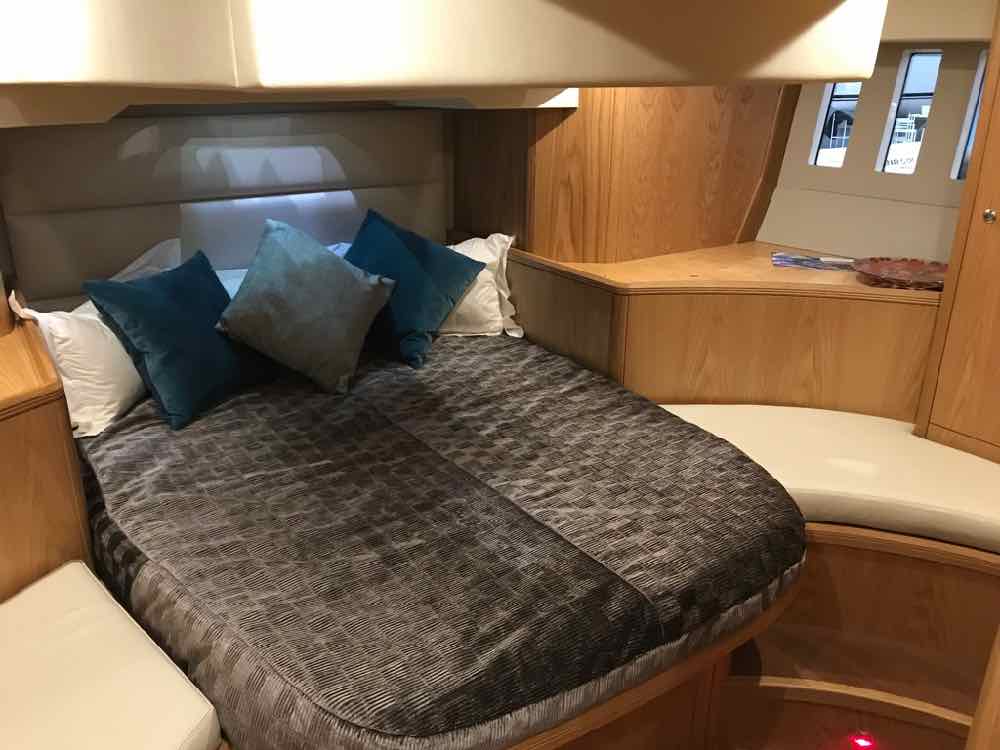
The aft heads also has a separate shower, and includes a wet locker for foul weather gear.
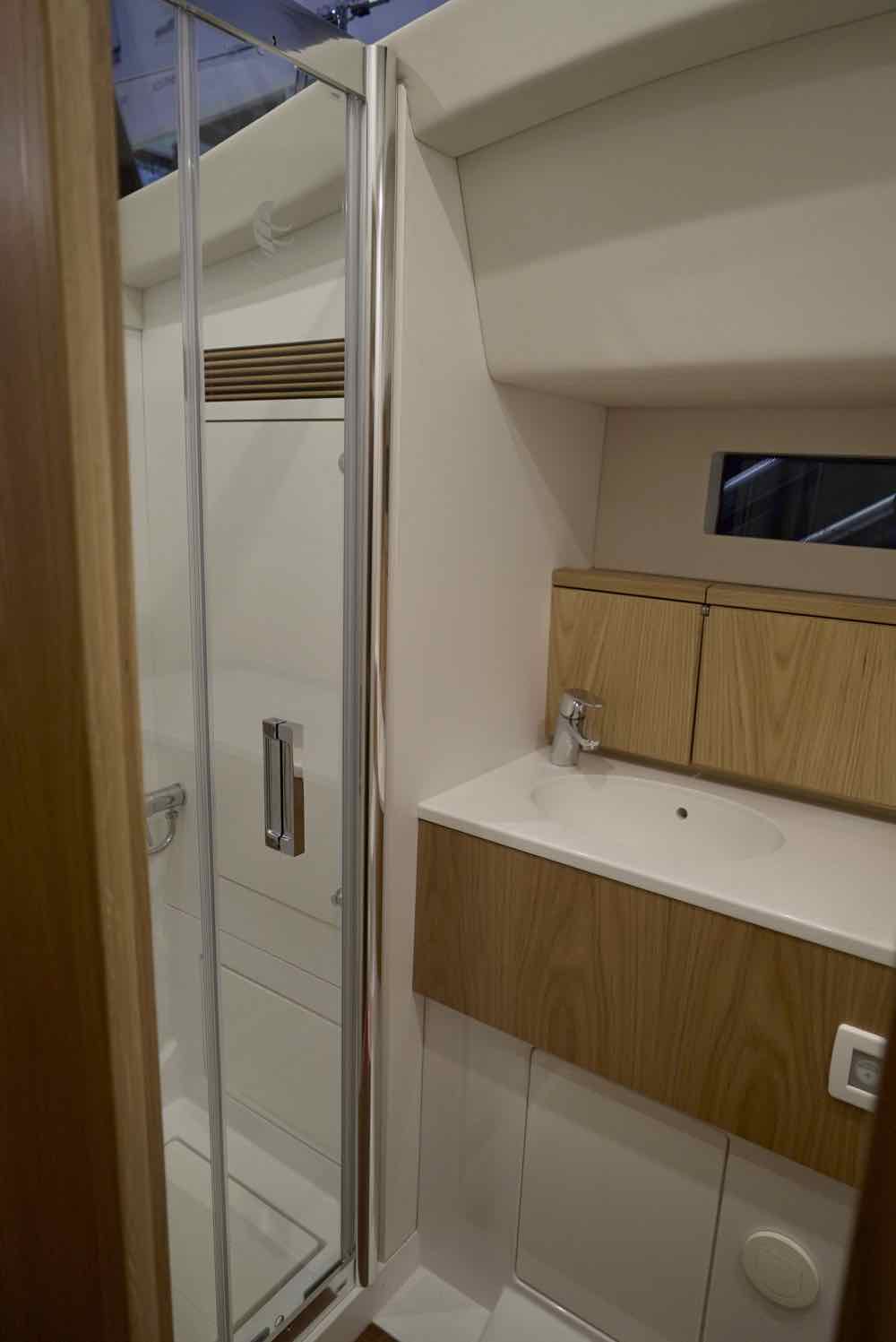
Distant Shores III draws just 1.0 meters or 3'3" with the keel up. Here's a stern view also showing our Varifold 4-blade propellor and the twin rudders.
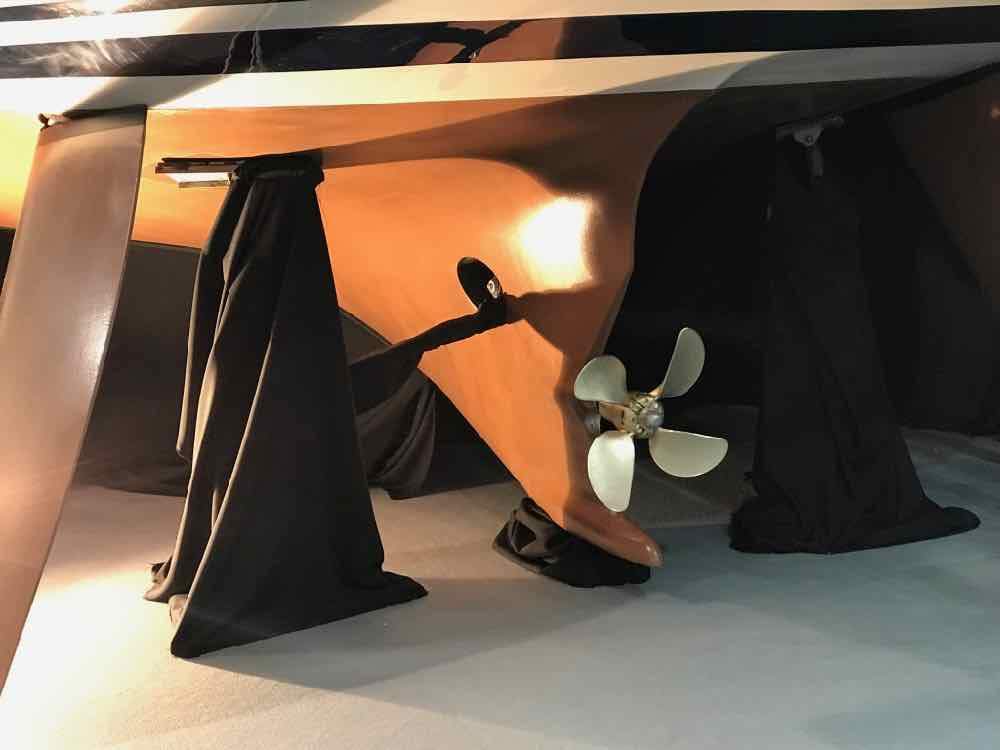
If you are in the area please drop by the Discovery stand to say hello and let us show you around. Boot Dusseldorf is "THE" show to see with more sailing yachts in one place than I have ever seen!
Boot Dusseldorf is the largest indoor boat show - plus this year it has Distant Shores III in the show!! So here's a quick tour around so you can see what she looks like…

Here's the view as we walked in to see her finished for the first time!


There is a spacious aft cockpit with centre table. The aft cabin is under the cockpit and the table acts as a skylight.

The galley is right at the bottom of the companionway for easy access. There is a fore-aft mounted fridge and a top loading freezer. The stove is a GN Espace model we've been excited to try out.

The saloon is raised for excellent views while seated.

Forward are the bunk cabin and large double stateroom…

The bunk room has two good sea-berths and plenty of storage. It also has notices asking people not to sit or lie down on the bunks please - but they don't seem to work :-)

The forward cabin is large with lots of stowage…

The forward heads has a separate shower.

Back in the saloon the nav station has views forward so you can steer (using the missing Raymarine autopilot and plotter)

The aft cabin is palatial spanning the width of the stern under the cockpit. The cockpit table above provides 4 ventilation hatches. Side hull windows provide a good view.

The aft heads also has a separate shower, and includes a wet locker for foul weather gear.

Distant Shores III draws just 1.0 meters or 3'3" with the keel up. Here's a stern view also showing our Varifold 4-blade propellor and the twin rudders.

If you are in the area please drop by the Discovery stand to say hello and let us show you around. Boot Dusseldorf is "THE" show to see with more sailing yachts in one place than I have ever seen!
Comments
Distant Shores III Update
09/01/18 18:21
It's been a while since I posted an update on the progress of Distant Shores III. Here she is in the factory in Southampton with shipwrights swarming over her :-)
So much has been done since we visited in the beginning of November!!
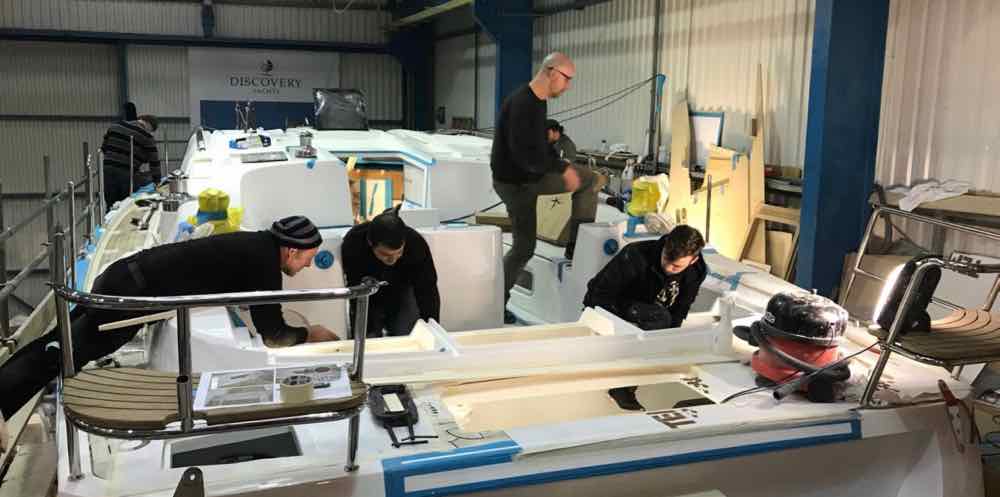
We visited back in November before heading off on the catamaran to cross the Atlantic
At that time Discovery were still finishing up the plug for the deck. It's taken a while but here in this photo is nearly complete…
Meanwhile the hull and interior is moving ahead well. Bulkheads are all in and interior modules are being fitted.
Over in the joinery department (woodworking) the last of the interior is being completed. This is the forward cabin V-berth. Pieces like this are completed outside the boat then installed as a whole module and glassed into the hull.
Jump ahead to early December and the deck has been laid up and is being pulled from the mould. In the lower part of the photo you can see the steel frame that keeps the mould perfectly strong and true. It is on rollers to move it around.
The hull layup has been complete for some time and has now been painted with anifouling - in this case we're giving "Copper Coat"… a try.

First trial fitting of the deck.
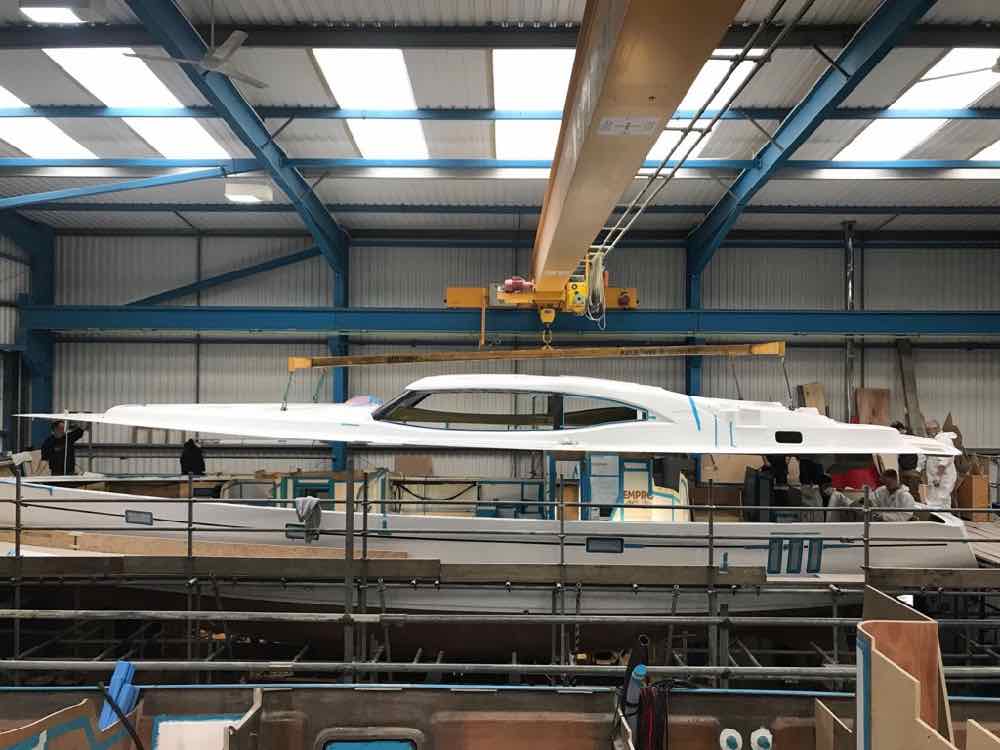
The bulkheads have been put in somewhat tall and must now be cut down to the proper height to be a perfect fit. This process can take a few hours to trim it just so before it can be settled in place permanently.
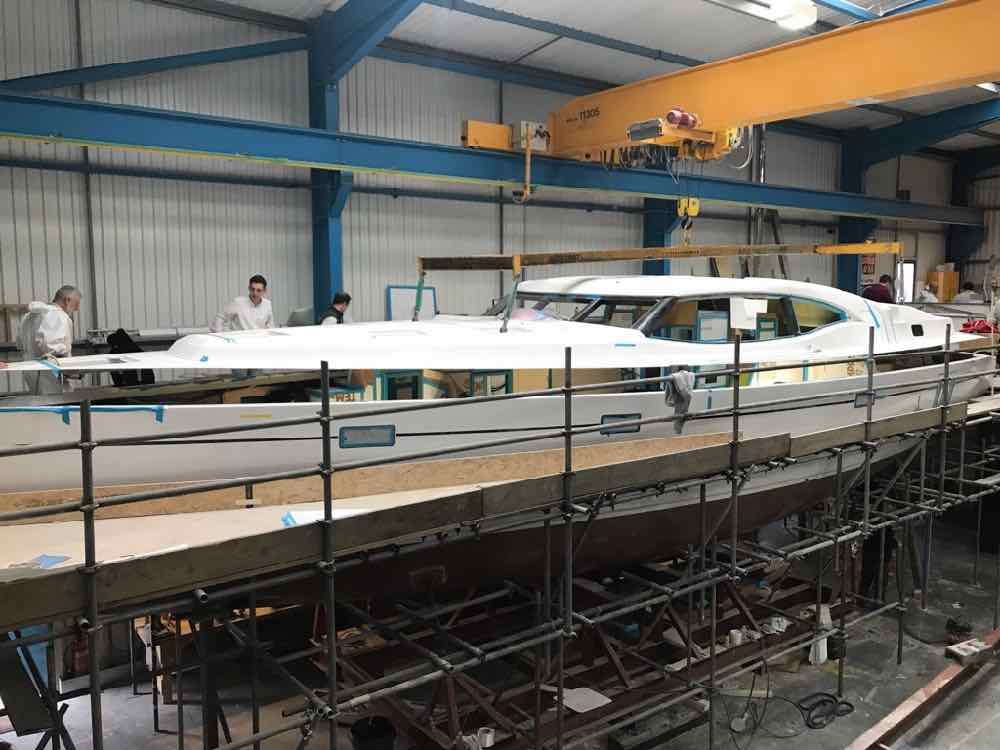
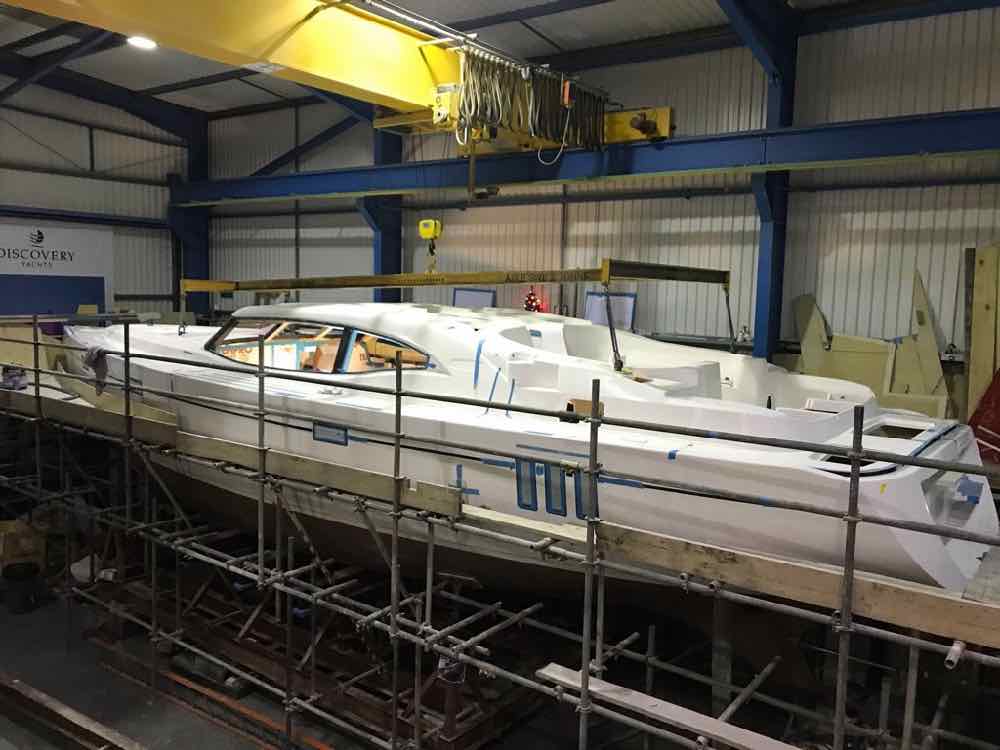
Today much more is complete! Hatches and deck hardware, windows and teak decking… but there is still much to do before Distant Shores III is slated to head off to the boat show in Dusseldorf THIS Weekend!
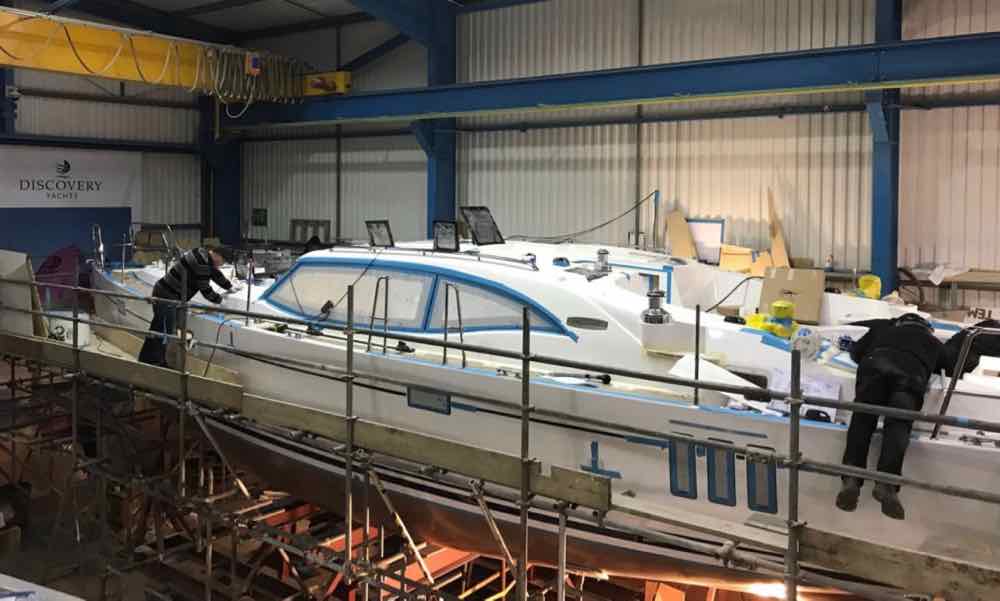
The boat show in Dusseldorf (January 20-28) this year) is the biggest indoor show in the world and has a huge variety of boats big and small. The venue is located right on the Rhine River so yachts can motor up and "Big Willi" will lift them from the water and its a short ride to the halls to display.
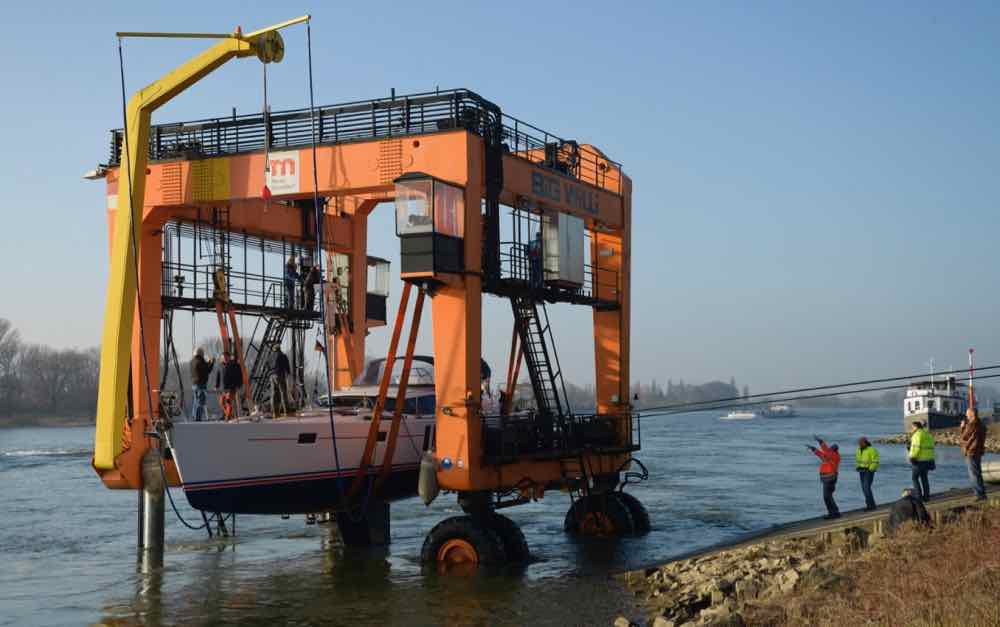
There are more cruising sailboats here than I've ever seen in one location - including some quite large ones.
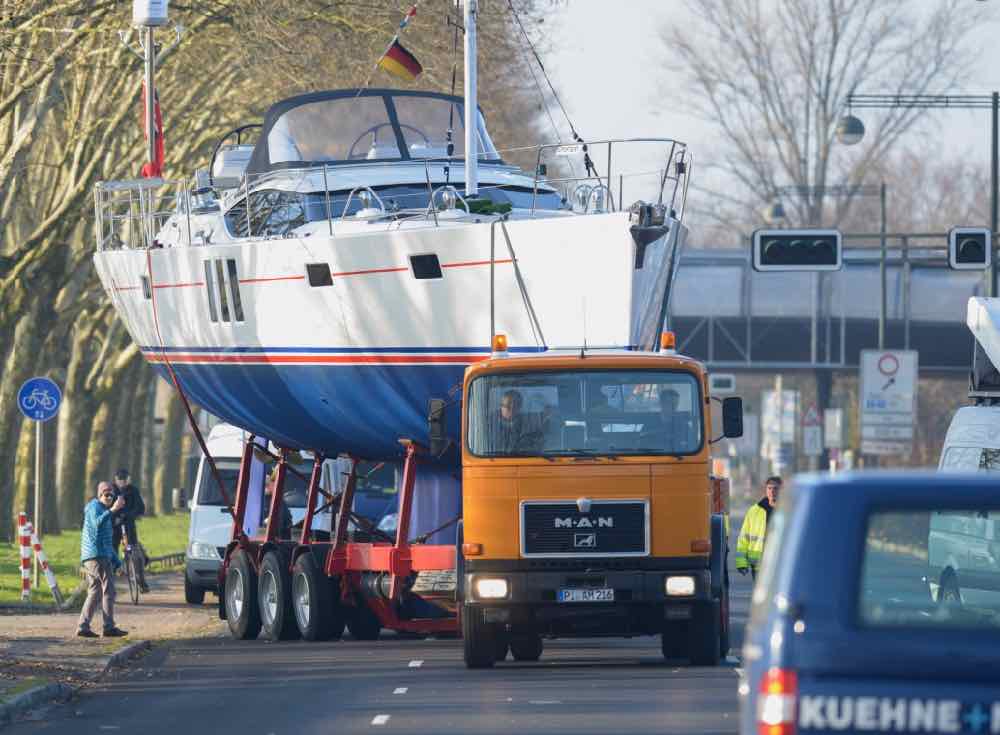
For power yacht enthusiasts there are some truly amazing boats you would never expect to see indoors! (seen here trundling to the building a few days ago)

It's a great show if you're trying to find your dream boat since more boats are in this one venue and you have days to compare them!
Photos courtesy of Messe Düsseldorf/ctillmann
Here is a short video I made of the Dusseldorf show …
If you're thinking of coming over to check out the show (and see Distant Shores III of course) please let us know!
So much has been done since we visited in the beginning of November!!

We visited back in November before heading off on the catamaran to cross the Atlantic
At that time Discovery were still finishing up the plug for the deck. It's taken a while but here in this photo is nearly complete…
Meanwhile the hull and interior is moving ahead well. Bulkheads are all in and interior modules are being fitted.
Over in the joinery department (woodworking) the last of the interior is being completed. This is the forward cabin V-berth. Pieces like this are completed outside the boat then installed as a whole module and glassed into the hull.
Jump ahead to early December and the deck has been laid up and is being pulled from the mould. In the lower part of the photo you can see the steel frame that keeps the mould perfectly strong and true. It is on rollers to move it around.
The hull layup has been complete for some time and has now been painted with anifouling - in this case we're giving "Copper Coat"… a try.

First trial fitting of the deck.

The bulkheads have been put in somewhat tall and must now be cut down to the proper height to be a perfect fit. This process can take a few hours to trim it just so before it can be settled in place permanently.


Today much more is complete! Hatches and deck hardware, windows and teak decking… but there is still much to do before Distant Shores III is slated to head off to the boat show in Dusseldorf THIS Weekend!

The boat show in Dusseldorf (January 20-28) this year) is the biggest indoor show in the world and has a huge variety of boats big and small. The venue is located right on the Rhine River so yachts can motor up and "Big Willi" will lift them from the water and its a short ride to the halls to display.

There are more cruising sailboats here than I've ever seen in one location - including some quite large ones.

For power yacht enthusiasts there are some truly amazing boats you would never expect to see indoors! (seen here trundling to the building a few days ago)

It's a great show if you're trying to find your dream boat since more boats are in this one venue and you have days to compare them!
Photos courtesy of Messe Düsseldorf/ctillmann
Here is a short video I made of the Dusseldorf show …
If you're thinking of coming over to check out the show (and see Distant Shores III of course) please let us know!
Planning a World Cruise
29/07/17 13:50
It's a very exciting time planning an upcoming cruise! Whether you are planning a summer cruise of a week or two, or planning something a little longer as we are… the planning stage should be a fun exercise as well as a chance to learn about your destinations and route.
In our case we're planning our first trip out into the Pacific Ocean to the Galapagos, Marquesas, French Polynesia and onwards. But first we will be back in the UK to collect our new Distant Shores III next spring, so our planning starts there.
The new boat will be ready in time to appear in the Dusseldorf Boat Show in January. Then she'll be back in the UK for final checks before splashing her in the Solent for our initial test-sailing in late March. Below is a section of the pilot chart for March in the North Atlantic. It shows winds around force 4-5 with a slight preponderance from the W-SW and only 2-3% of calms. The red "10" in the English channel indicates that 10% of the time the waves are greater than 12 feet high. The next red line indicates 20% so our sailing ground will be between 10-20 percent waves above 12 feet. The open channel is likely to be "perky" ;-)
You can follow the link for the US Government site to download the pilot charts yourself, which all include a handy section on how to read them. http://msi.nga.mil/NGAPortal/MSI.portal?_nfpb=true&_pageLabel=msi_portal_page_62&pubCode=0003
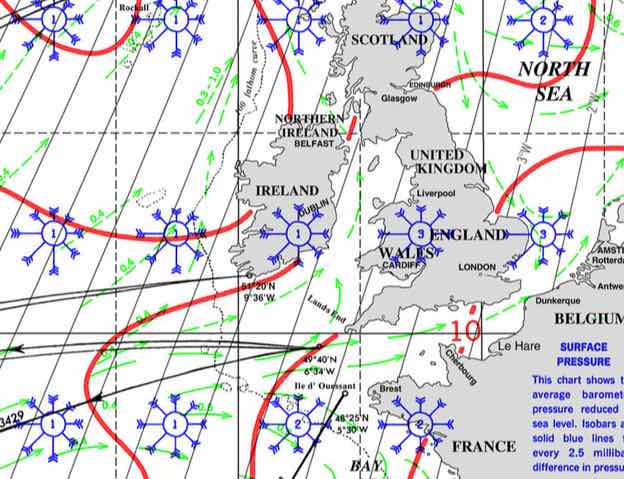
Of course it's still cold in March so we won't be planning very long passages. The Solent is a protected body of water with many nice harbours and uncrowded anchorages (that time of year) so it should be fun cruising while we get to know Distant Shores III.
We will also plan some "open day" events then so if you'd like to come and see Distant Shores III there will be an opportunity as well.
Looking forward to May with the weather becoming more pleasant we will be heading off on our first longer cruises. We'll cross the Channel to Guernsey in the Channel Islands and visit France as well. Then after one more trip back to the UK we'll set off on the big voyage.
The summer plan is to head south along France, then Spain and Portugal to Gibraltar. Way back in 2007 we sailed this coast in December (Yikes!) so are expecting a much warmer cruise with a chance to poke in some of the harbours we missed that time!
Next we'll sail across to the Caribbean in November - arriving in Antigua in December to complete 2018 with a Caribbean Christmas.
Here is our recent video Q&A on planning the world voyage.
Are you planning a cruise in the next 1-2 years?
In our case we're planning our first trip out into the Pacific Ocean to the Galapagos, Marquesas, French Polynesia and onwards. But first we will be back in the UK to collect our new Distant Shores III next spring, so our planning starts there.
The new boat will be ready in time to appear in the Dusseldorf Boat Show in January. Then she'll be back in the UK for final checks before splashing her in the Solent for our initial test-sailing in late March. Below is a section of the pilot chart for March in the North Atlantic. It shows winds around force 4-5 with a slight preponderance from the W-SW and only 2-3% of calms. The red "10" in the English channel indicates that 10% of the time the waves are greater than 12 feet high. The next red line indicates 20% so our sailing ground will be between 10-20 percent waves above 12 feet. The open channel is likely to be "perky" ;-)
You can follow the link for the US Government site to download the pilot charts yourself, which all include a handy section on how to read them. http://msi.nga.mil/NGAPortal/MSI.portal?_nfpb=true&_pageLabel=msi_portal_page_62&pubCode=0003

Of course it's still cold in March so we won't be planning very long passages. The Solent is a protected body of water with many nice harbours and uncrowded anchorages (that time of year) so it should be fun cruising while we get to know Distant Shores III.
We will also plan some "open day" events then so if you'd like to come and see Distant Shores III there will be an opportunity as well.
Year 1
Looking forward to May with the weather becoming more pleasant we will be heading off on our first longer cruises. We'll cross the Channel to Guernsey in the Channel Islands and visit France as well. Then after one more trip back to the UK we'll set off on the big voyage.
The summer plan is to head south along France, then Spain and Portugal to Gibraltar. Way back in 2007 we sailed this coast in December (Yikes!) so are expecting a much warmer cruise with a chance to poke in some of the harbours we missed that time!
Next we'll sail across to the Caribbean in November - arriving in Antigua in December to complete 2018 with a Caribbean Christmas.
Here is our recent video Q&A on planning the world voyage.
Are you planning a cruise in the next 1-2 years?
Crossing an Ocean
28/06/17 12:57
I'll always remember the sense of accomplishment Sheryl and I felt as we came in to Horta in the Azores after crossing our first ocean. Wow! We were tired and ready for a real night's sleep. It had been an 18-day double-handed crossing with sleep in 3-4 hour stretches and included our biggest storm to date. Boy were we thrilled to have sailed across the Atlantic!
 That was way back in 1990 in our first year of cruising/living aboard. We've since spent hundreds of days at sea out of sight of land including 6 more Atlantic crossings but the thrill of that first one is still a life memory.
That was way back in 1990 in our first year of cruising/living aboard. We've since spent hundreds of days at sea out of sight of land including 6 more Atlantic crossings but the thrill of that first one is still a life memory. The Proper Yacht - Room for Crew
On that first ocean crossing we were aboard Two-step, a Sparkman & Stephens design, we built ourselves from a bare hull and deck. This 37-footer was a small boat inside and a wet boat with low freeboard, but we sailed her 68,000 miles and three times across the Atlantic before moving up to our next boat. (The second picture is our third boat, Distant Shores II, a Southerly 49, sailing downwind wing-and-wing. Much nicer!)
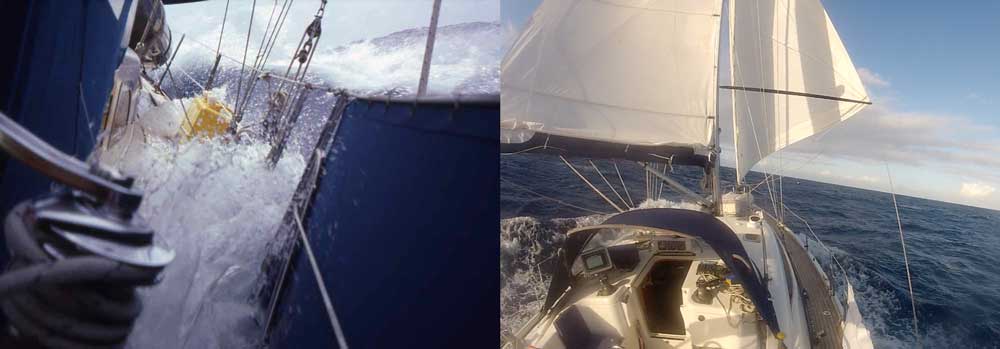 But perhaps one of Two-Step's biggest shortcomings was that she was a bit too small for bringing along additional crew. Doing watches 3 to 4 hours-on-/3 to 4 hours-off gets tiring. Nowadays we prefer doing passages with additional crew. Even one more crew means you can reduce the watch schedule, 4 people total and it makes a much more pleasant passage where everyone gets much better sleep.
But perhaps one of Two-Step's biggest shortcomings was that she was a bit too small for bringing along additional crew. Doing watches 3 to 4 hours-on-/3 to 4 hours-off gets tiring. Nowadays we prefer doing passages with additional crew. Even one more crew means you can reduce the watch schedule, 4 people total and it makes a much more pleasant passage where everyone gets much better sleep. Our new boat, Distant Shores III, a Southerly 480, is being built from the ground up with the plan to accommodate extra crew on passages. Distant Shores II could only handle 4 people on offshore passages in comfort. Distant Shores 3 is designed to have 6 aboard (Sheryl & I plus 4 additional crew) and we are planning safe comfortable sea berths for all. Here is an interior plan… For Offshore we will have a maximum of 6 people total aboard including us, and crew can choose the best berths for the conditions and preferences.
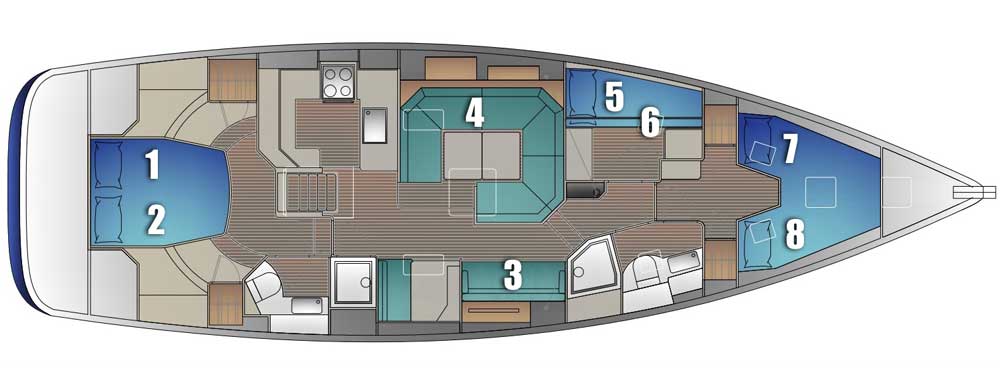
What's it Like at Sea?
It's not all storms and excitement on the ocean, although we certainly expect some exciting squalls on this passage. The transatlantic trade wind crossing to the Caribbean from Europe is likely to be all downwind. We have had a few calm days on 3 of our 4 east-to-west crossings on this route, but mainly the trades blow 15-20 knots or more from the east. We set the sails and roll along downwind, sometimes not even adjusting the sails for days on end. Typically there are squalls that pass regularly bringing rain and winds gusting up to 30 or so.
Here is a video from our recent Atlantic crossing in 2015 as we are completing our crossing the Atlantic to St Lucia. Everyone is very excited!
Offshore Ocean Overnight
If you've never done an overnight passage on a sailboat the thought of crossing an ocean and spending perhaps 18 days out of sight of land might well be daunting. In that case we would recommend a shorter passage first - one or two nights just to see if you like it.
View Schedule - Legs - Availability - Click Here
Do You Want to Cross an Ocean?
This isn't a dream for everyone! It's a big adventure and requires a big commitment in time. But if you dream of crossing an ocean then the trade-winds crossing of the Atlantic from the Canary Islands to the Caribbean is certainly one of those dream passages. Setting off in cooler fall weather from the Canary Islands, we head south for a few days. Tradition says "sail south until the butter melts" but with modern weather routing software we can make a better plan than that! On our last crossing we stopped at the Cabo Verde Islands, and we plan to do this again on our next crossing too. The islands are dramatic and friendly and it's a nice way to get 850 miles under your belt, then take a few days rest before jumping off for the big transatlantic crossing.
Join us Aboard Distant Shores III
We have always enjoyed bringing people along with us through our television shows to share the ocean life. Now with Distant Shores III we have planned the boat so we can bring along 4 additional crew and share the lifestyle directly. We have planned some passages in our Sail Away Weeks schedule. The big one is crossing the Atlantic (via the Cabo Verde Islands). We have planned 25 days this for adventure with probably 16-18 days at sea. That gives us a week or so in the Canary Islands, Cabo Verde Islands and Antigua when we arrive to celebrate!
For a smaller sampler of offshore sailing we are doing a passage from Gibraltar to the Canary Islands. We plan a stop in Morocco either at Rabat or Agadir. Either stop means there will be a leg of a few hundred miles (2-3 days) at sea on passage before we arrive in the Canary Islands at Lanzarote.
View Schedule - Legs - Availability - Click Here
If you'd like to join us for a "virtual" ocean crossing then why to check out our recent videos on the Atlantic crossing…
Join us aboard Distant Shores for the adventure of a lifetime crossing the Atlantic
Discovery Test Sail & DS3 Plans
29/04/17 12:07
Here is a (nearly final) drawing of our new Distant Shores 48, being built by Discovery Yachts. We're currently working with Discovery on the new design and think she's a beauty! A mainsheet arch keeps the cockpit clear while moving the attachment point to the boom aft. This is because mid-boom sheeting means high loads and a heavier boom as well. We learned from experience here (see Youtube). The pilot house design means more comfortable passages/night-watches as well as protection from the elements. Plus great views from the saloon! We'll get some better quality drawings in a couple of weeks!

We also shot a Vlog style YouTube (below) on a Discovery test sail in England. We sailed on a Discovery 55 (not the new 48 that we're building). We also fly our new drone, visit southwestern Cornwall, meet horses on the highway in the New Forest, and look around the Discovery Yachts factory in Southampton.
Most Discovery yachts are delivered with a Selden furling mast, and this one was the same, set up with standard Kemp Dacron sails. Some people recommend a high performance sail for in-mast furling units and I'm sorry we didn't have it to test. Nevertheless performance was quite acceptable and the boat pointed quite well with the self-tacker sheeted in.
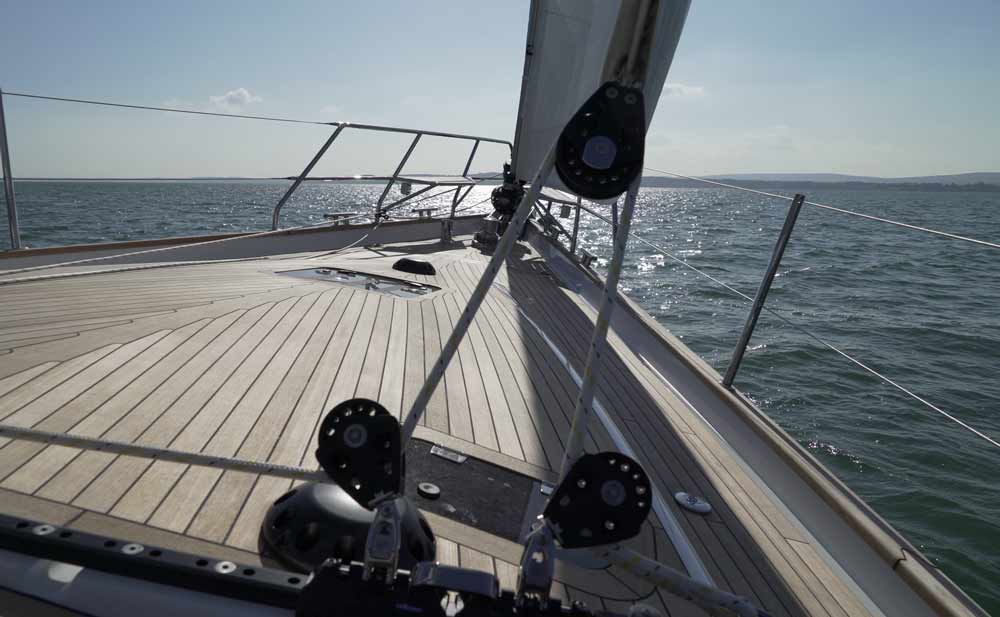
Looking at the self-tacking track above, I liked how it is rigged with the sheet running across the track. This is different from the way Southerly rigged it, and appeared to moderate the tacking procedure, smoothly sliding the car across. Nice!
Down belowdecks the main saloon has magnificent views from the saloon table, and also a forward view for a helmsman in inclement weather. Our new 48 will have similar views.

Building a new boat takes a while! We are hopeful the new Distant Shores 48 by Discovery will be ready in time for the Dusseldorf Boat Show in January 2018. Better get back to work!

We also shot a Vlog style YouTube (below) on a Discovery test sail in England. We sailed on a Discovery 55 (not the new 48 that we're building). We also fly our new drone, visit southwestern Cornwall, meet horses on the highway in the New Forest, and look around the Discovery Yachts factory in Southampton.
Discovery Test Sail
Most Discovery yachts are delivered with a Selden furling mast, and this one was the same, set up with standard Kemp Dacron sails. Some people recommend a high performance sail for in-mast furling units and I'm sorry we didn't have it to test. Nevertheless performance was quite acceptable and the boat pointed quite well with the self-tacker sheeted in.

Looking at the self-tacking track above, I liked how it is rigged with the sheet running across the track. This is different from the way Southerly rigged it, and appeared to moderate the tacking procedure, smoothly sliding the car across. Nice!
Down belowdecks the main saloon has magnificent views from the saloon table, and also a forward view for a helmsman in inclement weather. Our new 48 will have similar views.

Production Plans
Building a new boat takes a while! We are hopeful the new Distant Shores 48 by Discovery will be ready in time for the Dusseldorf Boat Show in January 2018. Better get back to work!
How to Sail with a Swing Keel
15/02/17 22:17
Throughout our 27 years of international cruising, Sheryl and I have sailed over 100,000 nm and 40,000 of those miles have been sailed on the two lifting-keel yachts - Distant Shores, a Southerly 42 and Distant Shores II, a Southerly 49. Many people have asked what it is like to sail such a boat, how they sail upwind, what to do in storms, what happens if you hit the keel, what to do in huge waves and more.
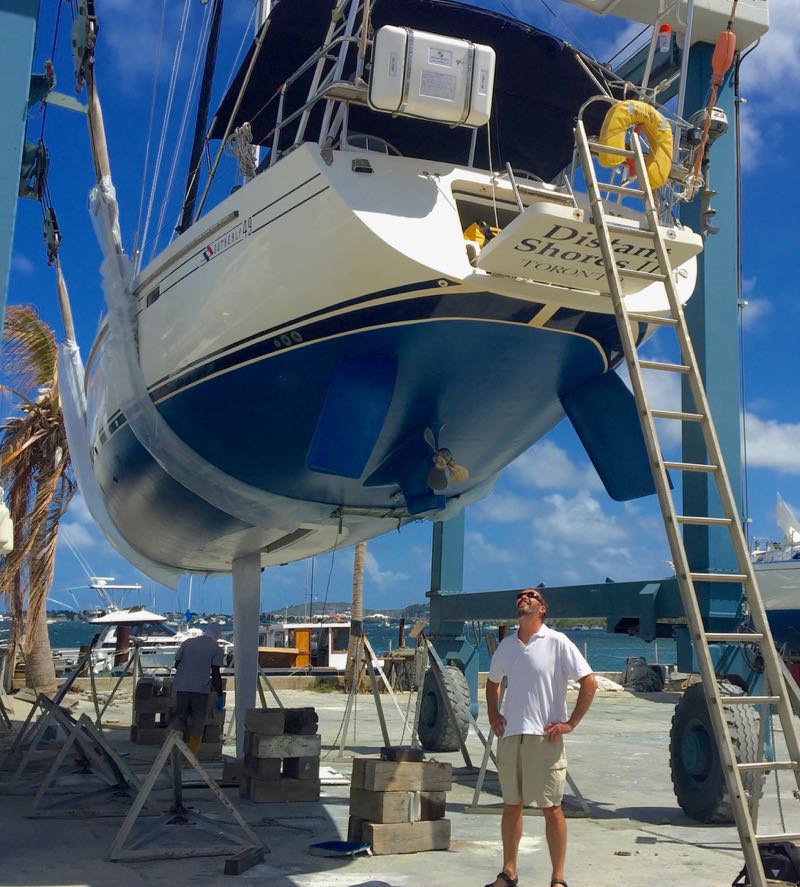
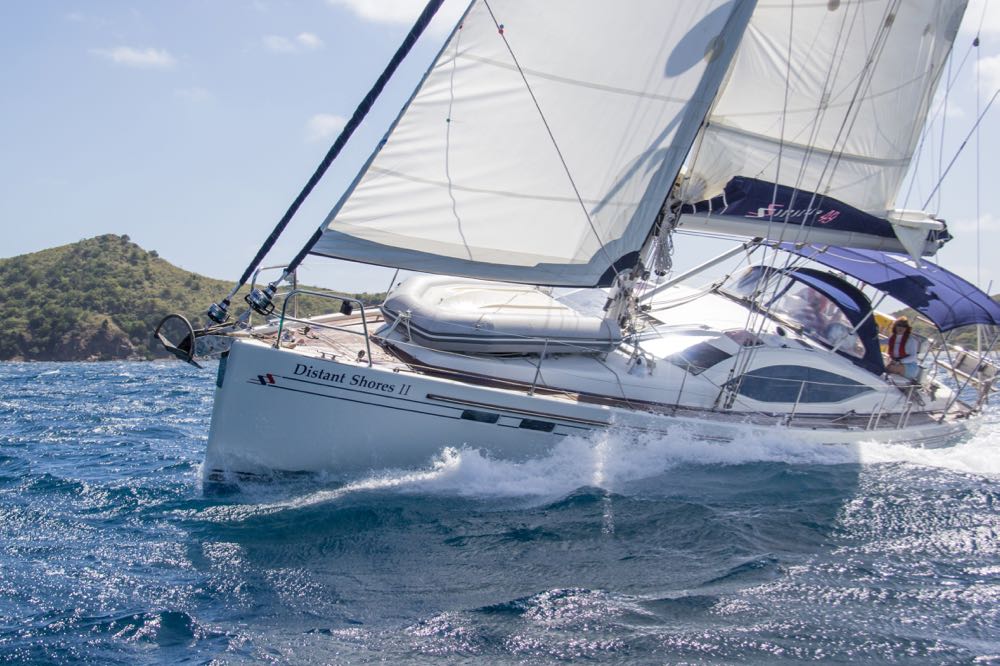

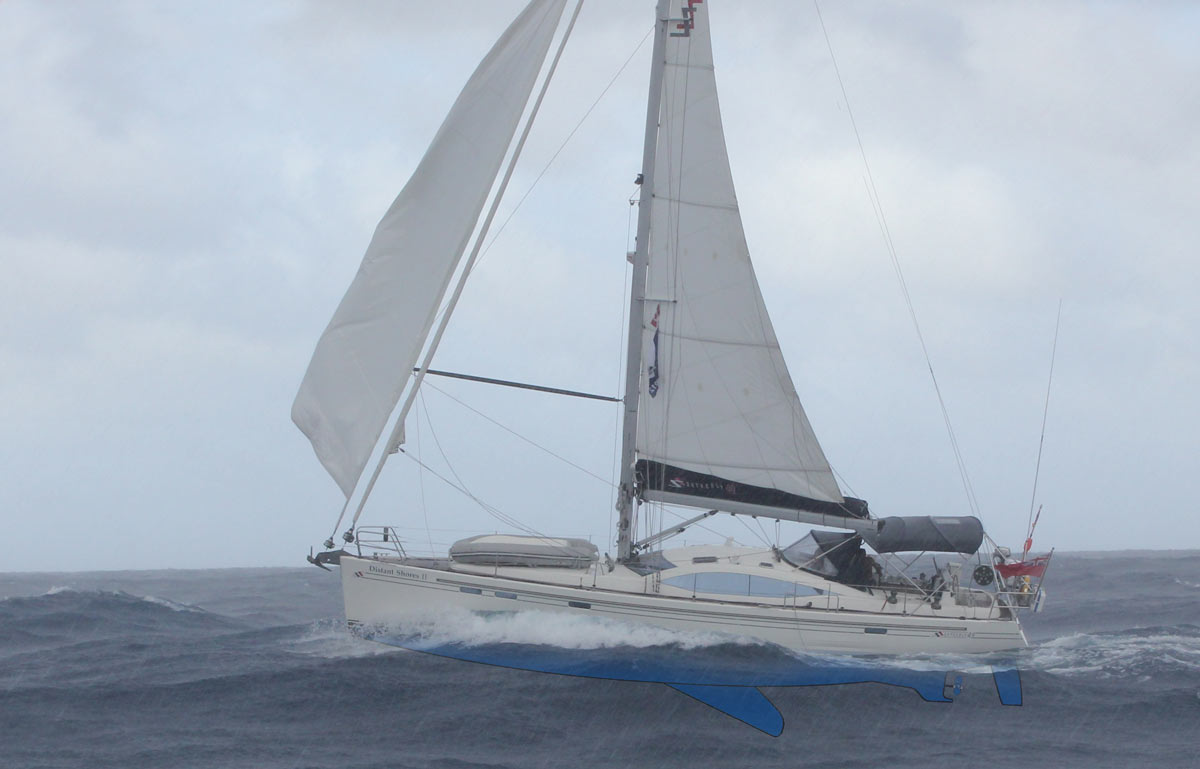
If you are considering buying a swing-keel yacht, please contact us for more information on the new Distant Shores III. She will have a swing keel just like Distant Shores and Distant Shores II and, based on our experience, she will be a great boat for a circumnavigation! We are currently working with a design team to develop this new model - to be launched later this year!
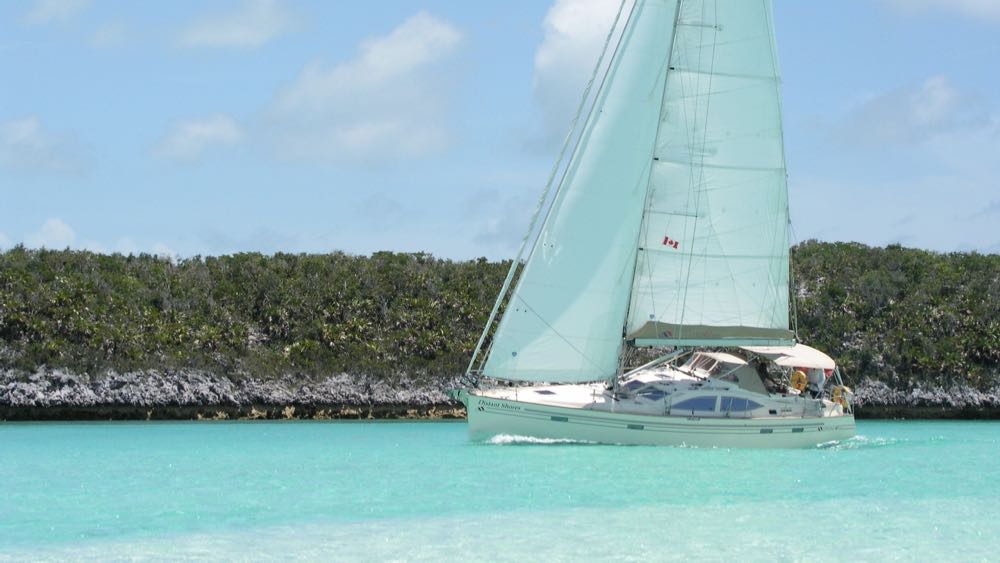
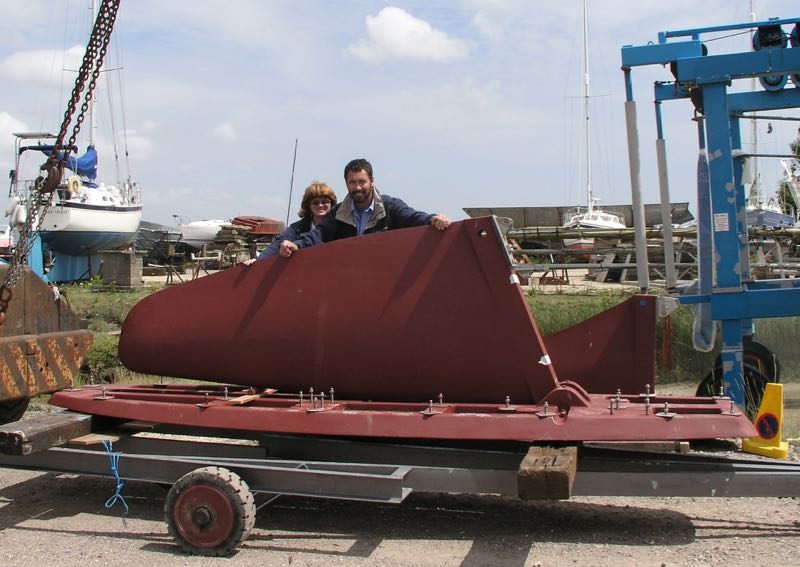

We're currently developing a new model of swinging keel shallow draft monohull. Distant Shores III be 48 feet long with a draft around 3' with the keel up. If you are in the market for a similar sailboat and would like more information please email us.
In an upcoming blog I will discuss how to sail a swing-keel yacht in heavy weather conditions…
Sailing Upwind
We always put the keel all the way down when working to windward. Our Southerly 49 draws 10' 3" (3.13m) with the keel down - an extremely deep aerofoil keel. Since the swing keel is also deeper than a conventional keel, it performs well upwind. The design doesn't carry as much weight deep down so the boats aren't as light or stiff as a racing boat, but they do well compared to a standard cruising boat with a moderate keel and offer many advantages to the cruising sailor. As you can see in the photo below, Southerly 49 keel at 10' 3" (3.13m) is a REALLY deep keel!
Aerofoil Keel Shape
Some centreboard boats have a flat board for a keel but the swing keels on the two Southerlys we've owned are both airfoil shaped and perform well upwind. I asked world-renowned yacht designer Rob Humphreys how important it was to have an aerofoil shaped keel. He said, "It’s vital, and not just for upwind performance. A well profiled aerofoil section keel optimizes the lift-drag ratio and widens the stall angle."
Sailing in Shallow Water
Whenever we are sailing in shallow water and there is a chance we might touch the bottom, we look over the chart and raise the keel to a comfortable depth. For example, when crossing the shallow Caicos Bank (photo below) we raise the keel halfway so we draw just 6-7 feet. The boat will still sail well, but she will not point as closely upwind. You can see we are close reaching. It is great to have this ability when exploring.
Broaching
Lifting the keel can reduce or eliminate the risk of the yacht broaching. According to cruising guru Jimmy Cornell, who owns a Garcia Exploration 45, "continuing to lift (the keel) up to the point where the board is fully retracted, is a great advantage as the risk of broaching is virtually eliminated. The absence of a keel to act as a pivot in a potential broaching situation means that the boat does not tend to round up when, in a similar situation, a keeled boat would do just that. It is a feature that I have blessed on many occasions and that has allowed me to continue keeping the spinnaker up longer than I would have done otherwise."Ocean Sailing Downwind
Before we sailed a Southerly Yacht across the ocean (we've now done it 5 times), I wondered what it would be like on a boat with a swing keel. Talking with other sailors who owned shallow-draft swing-keel yachts, I realized there were more options for sailing efficiently if you have a lifting keel. Swinging the keel up to raise it means you have actually moved the centre of lateral resistance backwards. It's possible to use this to your advantage when sailing downwind. Normally the yacht designer has carefully calculated the best position to mount a fixed keel. For a yacht with a swing keel, the design is done to optimize performance with the keel all the way down. When we swing the keel partially up, the centre of effort moves aft as you can see in the diagram below. We use this to improve performance when sailing downwind plus it reduces helm effort. It is similar to sailing a dinghy. With the keel most 70 percent raised, we have modified the bottom profile so the boat is more like an arrow. In this position the boat loves to sail downwind!
Distant Shores III
If you are considering buying a swing-keel yacht, please contact us for more information on the new Distant Shores III. She will have a swing keel just like Distant Shores and Distant Shores II and, based on our experience, she will be a great boat for a circumnavigation! We are currently working with a design team to develop this new model - to be launched later this year!
Swing Keel FAQ

Can you sail with the keel up?
Yes. The boat is safe to sail with the keel in any position including raised all the way up. Naturally the boat makes a lot of leeway when going to windward with the keel completely retracted, but she only heels a few more degrees. To understand this you can look at the image below of the keel for our Southerly 49 before it was installed during the build. The keel assembly consists of the massive grounding plate (weight 3180 kilos) plus the swinging keel at 2050 kilos. When you swing the keel up the centre of gravity does raise but not by enough to effect the safety or heeling by very much since so much of the ballast is in the grounding plate. In the picture above we have the keel of our Southerly 42 almost all the way up sailing the shallows of the Bahamas. We are drawing about 4.5 feet instead of our usual 9 feet (2.72m), the deepest draft of the Southerly 42. We are beating upwind and, despite making more leeway than usual, she still makes progress upwind.
What happens if you run aground?
The keel is designed to swing up into the hull when raised. Since it pivots on its front bearing in normal operation there is no damage if you hit something. Of course we try not to run aground, especially when moving at speed. The lifting pennant goes slack and the boat slows down. This is unlike a "vertically-lifting" centreboard which can be damaged by hitting something as the board jams in its case.
Does the board rattle?
We have never heard the keel move while sailing either of our Southerlys. We do not call it a centreboard since the weight and profile make it more like a regular keel. The swinging keel part of the assembly weighs 2050 kilos (4400 pounds) on the Southerly 49 which is about the same as a BMW 740 automobile! I don't think it could rattle. When we drop the keel down all the way it makes a thump as it comes to rest in the stops in the massive grounding plate.Does the keel require maintenance?
Yes. The keel lifting mechanism is a system and as such has a maintenance schedule. Once a year we check the hydraulic level, and every five years we replace the pennant that lifts the keel.Are you considering a Swing-Keel Sailboat?
We're currently developing a new model of swinging keel shallow draft monohull. Distant Shores III be 48 feet long with a draft around 3' with the keel up. If you are in the market for a similar sailboat and would like more information please email us.
In an upcoming blog I will discuss how to sail a swing-keel yacht in heavy weather conditions…
Ultimate Passagemaking Sailboat - Accommodations
03/10/16 13:26
By Paul Shard, Copyright 2016. All rights reserved.
Are you planning an extended cruise? Is "bluewater cruising" in your future? If so you may be planning to bring additional crew along on some of the offshore passages. Read on!
Planning our ideal passage-maker I have been looking at other layouts in the 45-50 foot range. Here are a few of the best known names in offshore monohulls. Hallberg-Rassy, Oyster, Hylas, and comparing to our last boat, the Southerly 49. We're looking at planning a passage with the two of us aboard, and planning to have extra crew join us on some longer passages. Let's see how the boat would accommodate the extra 1-3 people on passage, as well as how the boat could be set up for extra guests on routine sailing and exploring.
In these images below I have labelled the preferred berths as I would assign them to my passaging crew. We need to look after our crew!
Oyster 475

Above is the Oyster 475 with a lovely large aft owner's cabin. The galley is nicely located near the centre of the boat for reduced motion. On passages I would plan to use the aft cabin with lee-cloths to keep off-watch crew secure. There are 2 more sea berths just forward of the mast, and if a fifth person was aboard they could use the saloon settee. If going downwind of course you could use the forward cabin, but on many passages that berth will have too much motion for this watch keeper :-) So the Oyster layout will give you an extremely comfortable boat for the typical cruising couple, plus accommodate 3 additional crew for passages all in their own bunks.
Hallberg-Rassy 48 MkII

Here is an interesting take on an interior designed to look after 2 couples in style. The forward cabin is called a "Super Cabin" by Hallberg-Rassy who correctly suggest most cruising boats are sailed by 1 or 2 couples. Instead of a lot of small cabins common to ex-charter boats, they propose 2 very nice cabins and a smaller 3rd cabin forward. Seems like a good idea. For passage making there are great bunks for 4 people, but the 5th would need to climb over the 4th in my picture above. Both the 2 luxurious cabins have separate showers - nice!
Hylas 49

The classic Hylas layout again has 2 people in the luxurious aft owner's cabin (separated by a lee cloth). The 3rd crew have a private cabin just forward of the mast, then 4th and 5th crew get to curl up a bit on the saloon settees. This is another nice layout for a couple, and there is a luxurious forward cabin for guests up forward, although they would likely not want to sleep there on passages unless downwind. Neither heads appear to include a separate shower. The large galley is nicely positioned near the companionway and narrow enough to keep the cook in place and comfy on passages.
Southerly 49 Distant Shores II

Distant Shores II - our Southerly 49 has the main owners cabin forward so we always moved out of it on passage and slept in the aft cabins. A third crew slept in the saloon, and finally the 4th could sleep forward, or divide one of the aft bunks. These cabins are a bit low to make access for the second berth bit difficult, so in practice we only did this a few times. Downwind I (Paul) used the forward cabin on our last downwind transatlantic passage. The galley is nice at sea… although there is a bit more motion than if the galley was aft. The forward shower is a dedicated unit.
Aft Cockpit or Centre Cockpit
I think many people will agree the main aft owner's cabin is a good feature. Aft cabins are great as they allow spacious headroom above the aft cabin, but this centre cockpit design means a smaller cockpit. We enjoyed the large forward stateroom on DS2 but did not like that we had to move aft for passages. Our 49 had that nice large cockpit, but paid the price with lower headroom in the 2 aft cabins.
What do you think?
Would you prefer an aft cabin, or aft cockpit? Or something else?
Mainsail Choices
09/07/16 15:58
By Paul Shard, Copyright 2016. All rights reserved.
What sort of mainsail setup is best for long-distance sailing?
On our first cruising sailboat - the 37 foot Two-Step - we had full battens and a rudimentary single-line reefing system. You can see the deep first reef in the picture below. By pulling the single line in the cockpit you would bring both reef points down to the boom using a pulley system hidden in the boom.
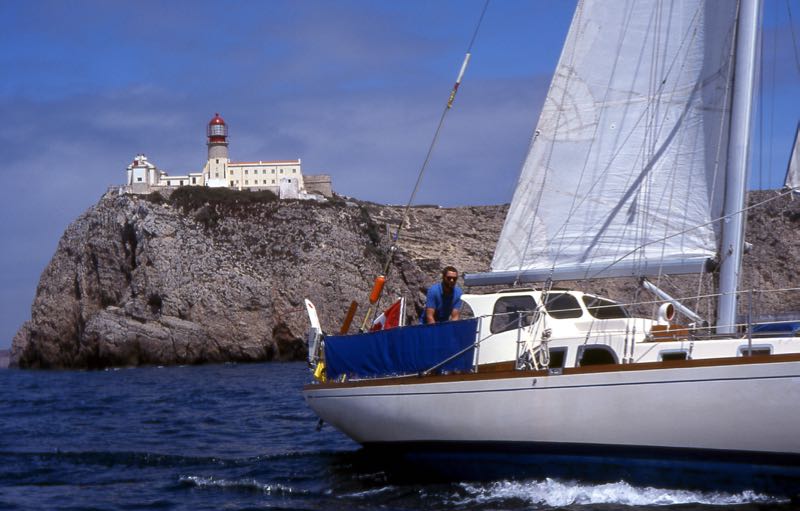
Unfortunately the sail-slides were just plastic and regularly broke. Also the single line system tended to get tangled inside the boom since the pulley system would spin around and add friction. Regularly we had to try to untangle the lines.
Both these shortcomings were eliminated by the clever setup in the Selden masts we had on our 2007 Southerly 42 Distant Shores. The sail slides are replaced by Selden's excellent roller car system … check out the link here
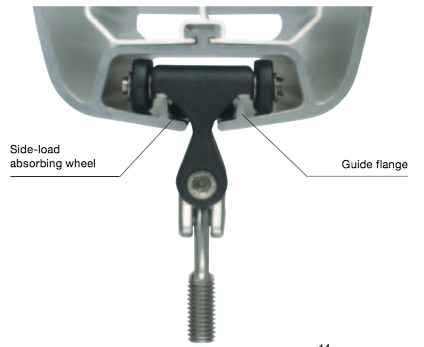
We also have this on the Southerly 49 and this system works VERY well. The cars slide easily, never bind and are quite strong. We carry a couple of spares, but in nearly 50,000 miles with this system we have only broken one car.
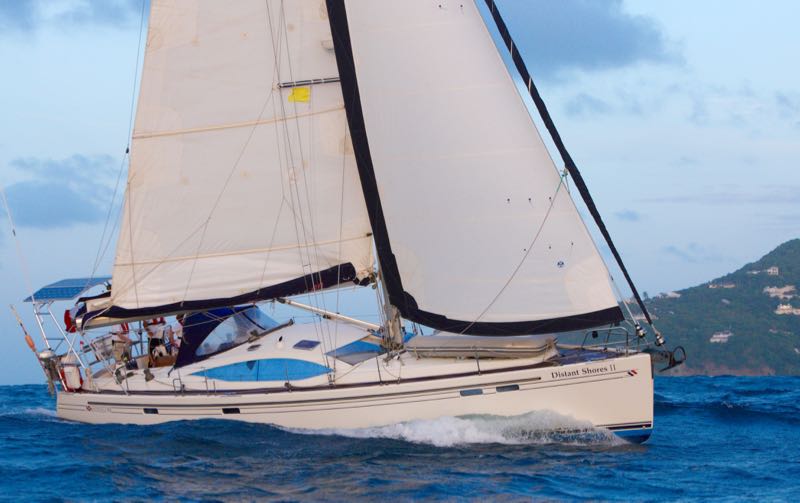
Reefing is similar to our original "single-line" system but with an important difference. The Selden system involves a car in the boom that cannot become tangled as it could on our older system on Two-Step. Basically the car moves back and forth inside the boom such that it can't rotate and twist. Clever solution to the problem. Here's link to Selden's website describing the system.
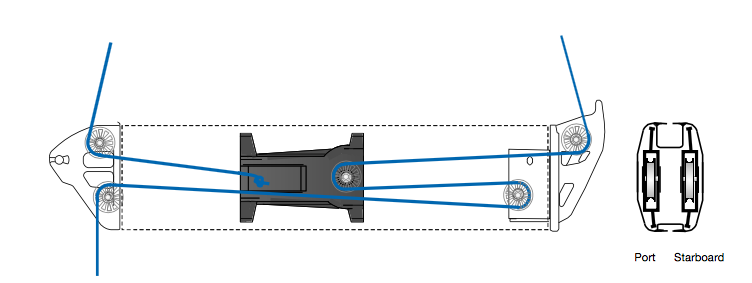
This system allows you to have 2 reef points, each reefed with a single line from the cockpit. We also have a third reef, but this can't be done the same way. We have that as a traditional jiffy-reef.
In-Mast Furling
We have never sailed offshore using an In-Mast or In-Boom furling solution, but I confess I have often wondered if its time to give them a try. In-Mast systems seem the most time-tested, and many boats have circumnavigated with this. On our last crossing there were numerous boats on the ARC with in-mast furling and I envied how easy it would be to reef in our out so easily. Here is a big Hallberg-Rassy 54 with a Selden inmast furling system and a full batten mainsail.
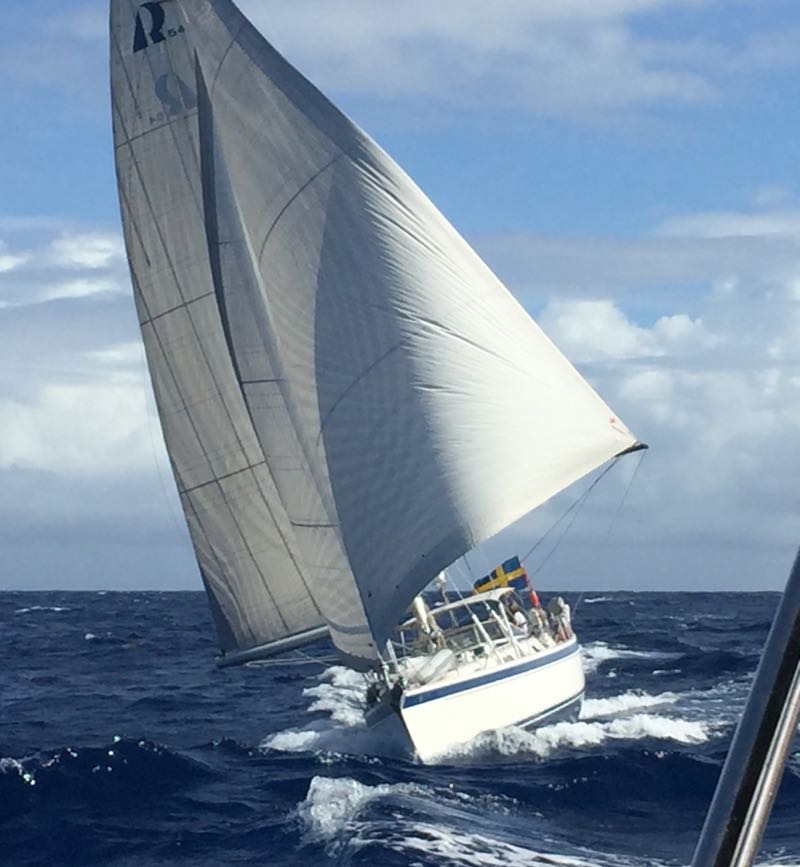
Our crew Anthony, an experienced offshore racer, has the Selden "In-Mast" system on his Bavaria 50 and has done a number of offshore races with it and thousands of miles. He got me thinking more seriously about giving it a try…
Disadvantages include added weight aloft and the potential for a jam if something goes wrong.
Advantages are ease of operation when sailing short-handed, your spend less time furling and covering the sail, and you're more likely get the sail out and set up on a light air day. We SO OFTEN see cruising sailors just motoring with the mainsail cover on when they might be able to sail. We might have been guilty of that ourselves on occasion…
If anyone has experience with this please chime in! Comments Please :-)